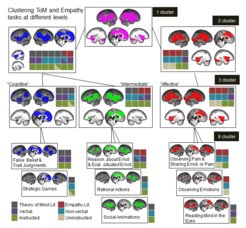Empathy and perspective taking: How social skills are built

It is not one specific skill that enables us to put ourselves in another person's shoes. These skills are made up of many individual factors that vary according to the situation.
Understanding what other people want, how they feel, and how they see the world is becoming increasingly important in our complex, globalised society. Social skills enable us to make friends and create a network of people who support us. But not everyone finds it easy to interact with other people. One of the main reasons is that two of the most important social skills - empathy, i.e. being able to empathise with the other person's emotions, and the ability to take a perspective, i.e. being able to gain an information by adopting another person’s point of view - are developed to different degrees.
Researchers have long been trying to find out what helps one to understand others. The more you know about these two social skills, the better you can help people to form social relationships. However, it still not exactly clear what empathy and perspective taking are (the latter is also known as “theory of mind“). Being able to read a person's emotions through their eyes, understand a funny story, or interpret the action of another person—in everyday life there are always social situations that require these two important abilities. However, they each require a combination of different individual subordinate skills. If it is necessary to interpret looks and facial expressions in one situation, in another it may be necessary to think along with the cultural background of the narrator or to know his or her current needs.

To date, countless studies have been conducted that examine empathy and perspective taking as a whole. However, it has not yet been clarified what constitutes the core of both competencies and where in the brain their bases lie. Philipp Kanske, former MPI CBS research group leader and currently professor at the TU Dresden, together with Matthias Schurz from the Donders Institute in Nijmegen, Netherlands, and an international team of researchers, have now developed a comprehensive explanatory model.
"Both of these abilities are processed in the brain by a 'main network' specialised in empathy or changing perspective, which is activated in every social situation. But, depending on the situation, it also involves additional networks," Kanske explains, referring to the results of the study, which has just been published in the journal Psychological Bulletin. If we read the thoughts and feelings of others, for example, from their eyes, other additional regions are involved than if we deduce them from their actions or from a narrative. "The brain is thus able to react very flexibly to individual requirements."
For empathy, a main network that can recognise acutely significant situations, for example, by processing fear, works together with additional specialised regions, for example, for face or speech recognition. When changing perspective, in turn, the regions that are also used for remembering the past or fantasising about the future, i.e., for thoughts that deal with things that cannot be observed at the moment, are active as the core network. Here too, additional brain regions are switched on in each concrete situation.
Complex social problems require a combination of empathy and perspective taking
Through their analyses, the researchers have also found out that particularly complex social problems require a combination of empathy and a change of perspective. People who are particularly competent socially seem to view the other person in both ways—on the basis of feelings and on the basis of thoughts. In their judgement, they then find the right balance between the two.
"Our analysis also shows, however, that a lack of one of the two social skills can also mean that not this skill as a whole is limited. It may be that only a certain factor is affected, such as understanding facial expressions or speech melody," adds Kanske. A single test is therefore not sufficient to certify a person's lack of social skills. Rather, there must be a series of tests to actually assess them as having little empathy, or as being unable to take the other person's point of view.
The scientists have investigated these relationships by means of a large-scale meta-analysis. They identified, on the one hand, commonalities in the MRI pattern of the 188 individual studies examined when the participants used empathy or perspective taking. This allowed the localisation of the core regions in the brain for each of the two social skills. However, results also indicated how the MRI patterns differed depending on the specific task and, therefore, which additional brain regions were used.




